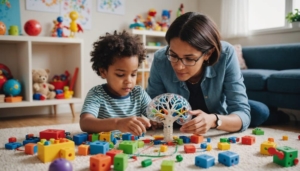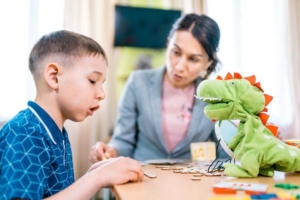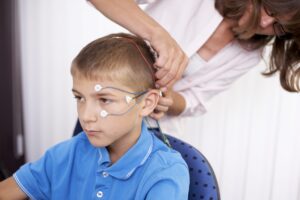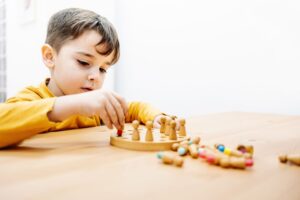بازی های مناسب برای افزایش حافظه و عملکرد اجتماعی کودکان مبتلا به ناتوانی یادگیری
نویسنده : عباس نداف ، درمانگر سایت مهارت اجتماعی ، دفتر کاردرمانی پیشیاره، تهران، ایران.
کودکانی که مبتلا به ناتوانی یادگیری هستند در یادگیری دروس مدرسه مشکل دارند یا به عبارتی دیگر ناتوانی یادگیری آسیب در یک یا چند فرآیند روانشناختی لازم برای درک و فهم یا استفاده از زبان، نوشتار یا گفتار است که ممکن است خود را در شکل توانایی ناقص برای گوش دادن، تفکر، تکلم، خواندن، هجی کردن یا انجام محاسبات ریاضی نشان دهد که در مجموع این فرآیند منجر به افت تحصیلی دانش آموزان می شود.
کودکان مبتلا به ناتوانی یادگیری املا نارسایی توجه و حافظه فعال، مشکلات واج شناسی، زبانی، اشکال در حافظه دیداری، شنیداری و حرکتی دیده می شود. با توجه به شرایط گفته شده اکثر این کودکان عکس العمل های منفی از سوی بزرگسالان و همچنین تمسخر از سوی همسالان را تجربه می کنند، به همین دلیل این کودکان علاوه بر مشکلات گفته شده در مهارت های بین فردی ضعف دارند و سطوح بالایی از تنهایی و طرد شدن را تجربه می کنند که در نتیجه این عدم توانایی و مشکلات اجتماعی با کاهش اعتماد به نفس در این کودکان همراه خواهد بود.
یکی از موثر ترین روش ها در بهبود این علایم بازی درمانی می باشد که با رویکرد های متفاوت انجام می شود. تحقیقات نشان داده است که بازی با رویکرد آموزشی در افزايش كاركرد حافظه كوتاه مدت و کاهش غلط های آموزشی، افزایش دقت، افزایش حافظه دیداری و شنیداری تاثیر دارد. به علاوه بازی های شناختی رفتاری در بالا بردن سطح شناخت کودکان از خود و اینکه بی نظیر هستند که باعث افزایش اعتماد به نفس آنها می شود تاثیر بسزایی دارد.
بازی های مورد نظر برای این کودکان:
- بازی بسکتبال و طراحی با نخ ها که در این نوع بازی به کودکان کاهش ترس از انتقاد دیگران را آموزش می دهیم و اعتماد به نفس آن ها را بالا می بریم.
- به کودکان در بازی های گروهی آموزش می دهیم (به صورت انفرادی هم موردی ندارد) احساسات خود را نسبت به هم و حتی نسبت به یک فعالیت بیان کنند.
- بازی ساختمان سازی با الگو و تصویر سازی ذهنی (طبق الگویی که می بینید عمل کنید)
- یازی پانتومیم و بررسی تفاوت های ظاهری یکدیگر در جهت افزایش اعتماد به نفس و برقراری رابطه با دیگران
- بازی مجسمه حرکت و اجرای دستورات به صورت معکوس
- کارت کلمات ناقص. در این بازی بر روی تکه هایی از مقوا کلماتی را ناقص بنویسید تا بچه ها آن ها را کامل کنند
- بازی عبور از ماز بر اساس الگوی اولیه. در این بازی هم گروهی ها می توانند به یکدیگر بازخورد هم بدهند و چاره اندیشی دست جمعی داشته باشند
- به کودکان فیلم نشان بدهید و سپس بخواهید همان صحنه ها را یادآوری و بازسازی کند
- بازی اجرای نقش معلم و دانش آموز و تصحیح دیکته های یکدیگر توسط خود کودکان با هم انجام شود.
در انتها می توانید به این موضوع نیز توجه داشته باشید که در تمامی بازی ها یا به صورت مجزا افزایش مهارت خودآگاهی، تقویت توانایی ها و تقویت احساس خود ارزشمندی را در کودکان ایجاد کنید.
REFERENCES:
Tehran: Avaye nour Publication;2011.[In Persian].
- Kakavand A. Child Psychopathology. Tehran: Virayesh Publication;2006.[In Persian].
- Schiff R, Bauminger N, Toledo I. Analogical problem solving in children with verbal and nonverbal learning disabilities. Journal of Learning Disabilities 2009; 42: 3-13.
- Lerner J W Learning disabilities: Theories, diagnosis, and teaching strategies. 9th ed. Boston, MA: Houghton Mifflin; 2003.
- Sadock B J, Sadock V A. Kaplan & Sadock’s synopsis of psychiatry. 10th ed. Philadelphia: Lippincott, Williams & Wilkins; 2007.
- Shekouhi Yekta M, Prand A. Learning disabilities. 2nd ed. Tehran: Tabib Publication; 2010:81-9.[In persian].
- Narimani M, Rajabi S. The Prevalence and causes of learning disorders among Elementary School Children in Ardebil. Research on Exceptional Children 2005;5(33):231-52. [In persian].
- Fletcher J M, Lyon G R, Fuchs L S, Barnes M A. Learning disabilities (from identification to intervention). New York: The Guilford press; 2007.
- Nathan AM. The impact of executive function skills on writing: A comparison of fifth-grade students with learning disabilities and students with typical development [Thesis]. America University of Nevada; 2009.
- Perry Ziegler J C, Colt hearth M. How predictable is spelling an analysis of sound spelling contingency in English. Quarterly. Journal of Experimental psychology. 2002; 55A(3): 897 – 915.
- Vlachos F. Karapetsas A. “Visual memory deficit in children with dysgraphia”. Journal of Perceptual Motor Skills 2003; 97: 1281 – 8.
- Meltzer L. Executive function in education: From theory to practice. New York: Guilford Press; 2007.
- Carretti B, Cornoldi C. De Beni R, Romano M. Updating in working memory: A comparison of good and poor comprehenders. Journal of Experimental Child Psychology 2005; 91: 45-66.
- Alloway T P. How does working memory work in the classroom? Educational Research and Reviews. 2006; 1(4): 134- 9.
- Westerberg H, Klingberg T. Changes in cortical activity after training of working memory-a single-subject analysis. Physiology & Behavior 2007; 92(1-2): 186–92.
- Seifenaraghi M, Naderi E. Learning Disability. Tehran: Amirkabir;2005. [In persian].
- Taroyan N A, Nicolson R I, Fawcett A J. Behavioral and neurophysiological correlates of dyslexia in the continuous performance task. Clinical Neurophysiology 2007; 118(4): 845-55.
- Auerbach J G, Gross-Tsur V, Manor O, Shalev R S. Emotional and behavioral characteristics over a six year period in youths with persistent and nonpersistent dyscalculia. Journal of Learning Disabilities 2008; 41: 263–73.
- Sideridis G D. International approaches to learning disabilities: More A like of more different? Learning Disabilities Research & Practice 2007; 22: 210-5.
- Klassen R M, Lynch S L. Self-efficacy from the perspective of adolescents with learning disabilities and their specialist teachers. Journal of Learning Disabilities 2007; 40(6): 494–507.
- Fristad, M A, Topolosky S, Weller E B, Weller R A. Depression and learning disabilities in children. Journal of Affective Disorders 1992; 26: 53–8.
- Merrel K W, Gimpel G A. Social skills of children and adolescents: Conceptualization, assessment and treatment. New Jerscy: Lawrence Erlbaum Associates, Inc; 1998.
- Gresham F, Elliot S. Social skills rating system manual. Cirele pine, MN: American Guidance service; 1990.
- Bauminger N, Edelsztein H S, Morash J. Social information processing and emotional understanding in children with LD. Journal of Learning Disabilities 2005; 38(1): 45–61.
- Wiener J. Do peer relationships foster behavioral adjustment in children with learning disabilities? Learning Disability Quarterly 2004; 27: 21 -30.
- Estell D B, Jones M H, Pearl R A ,Van Acker R ,Farmer T W, Rodkin P. Rpeer groups , popularity, and social preference: Trajectories of social Functioning among students with and without learning disabilities. Journal of Learning Disabilities 2008; 41(1): 5 -14.
- Loannis A, Efrosini K. Nonverbal social interaction skills of children with learning disabilities. Research in Developmental Disabilities 2008; 29(1):1-10.
- Mahjor SR. Play Psychology. 7th ed. Shiraz: Sasan Publication; 2007.[In persian].
- Springer C. Misurell J R. Game-based cognitive-behavioral therapy (GB-CBT): An innovative group treatment program for children who have been sexually abused. Journal of Child and Adolescent Trauma 2010; 3: 163-80.
- Kazdin Alan E.Encyclopedia of psychology. New York: Lexington Press; 2000.
- Springer C., Misurell JR, Hiller A. Game-Based Cognitive-Behavioral Therapy (GB-CBT) group program for children who have experienced sexual abuse: A three-month follow-up investigation. J Child Sex Abus 2012;21(6):646-64.
- Landreth GL, Ray DC, Bratton SC. Play therapy in elementary schools. Psychology in the Schools. 2009; 46(3): 281-9.
- Zare H, Amiri F, Taraj SH. The effect of educational games on short-term memory and dictation of Primary school students with specific learning disabilities. Research Institute on Exceptional Children 2010; 9:367-
- Abdi A , Karami M , Hatami J. The effect of improving visual memory through play therapy on reducing spelling errors in students with dysgraphia. Journal of Research in Rehabilitation Sciences 2012; 8: 6-11. [In persian]
- Baggerly J, Parker M. Child-centered group play therapy with African American boys at the elementary school level. Journal of Counseling & Development 2005; 83(4): 387-96.
- Hamilton D, Zoitas A. The social validity of interventions for promoting preschool children’s peerlnteractions. Journal Behaviour Change 2003; 20: 208-17.
- Jafari A, Khalatbari J, Todar R, Abolfathi H. Effect of play therapy with Meichenbaum cognitive – behavior approach on reduction shyness and social withdrawal of elementary School Children in Abhar. New findings in Psychology 2011; 6: 7-16.[In persian].
- Rashidi-Zafar M, Janbozorgi M, Shaghaghi F. Positive social behavior efficacy of play therapy on progress of pre-school children’s. Journal of Behavioral Sciences 2012; 6: 69-77. [In Persian].
- Guerney L. Play therapy with learning disabled children. Journal of Clinical Child Psychology 1979; 8(3): 216-8.
- Kosanj N, Yarmohamadian A, Faramarzi S, Abedi A. Spelling Learning Disability Identification Test. 2012; in press.[In Persian].
- Wechsler D. Wechsler intelligence scale for children. 3rd ed. San Antonio, TX: The Psychological Corporation; 1991.
- Wechsler, D. WISC-IV: technical and interpretation manual. San Antonio: The Psychological Corporation; 2003.
- Abedi A, Aghababaei S. Effectiveness of working memory training on academic performance of children with mathematics learning disability. Clinical psychology 2010; 2:73-81.[In Persian]
- Behpajoh A, Ghobari B, Hossein khanzadeh A, Hejazi E. A comparison of the social skills in hearingimpaired students at mutual schools and at segregated schools. Journal of Psychology & Education 2005; 35:63-83. [In Persian]
- Shahim S. Social skills in a group of educable mentally retarded children using the social skills rating system. Journal of psychology & education of Tehran University. 1999; 4:18-37.[In Persian].
- Seidman L J. Neuropsychological functioning in people with ADHD across the lifespan. Clinical Psychology Review 2006; 26: 466–85.
- Seidman L J, Valera E M, Makris N M. Structural brain imaging of attentiondeficit/ hyperactivity disorder. Biological Psychiatry 2005; 57:1263-72.
- Swanson L H, Jerman O. The influence of working memory on reading growth in subgroups of children with reading disabilities. Journal of Experimental Child Psychology 2007; 96(4): 249-83.
- Khodami N, Abedi A, Atashpor H. Effectiveness of executive functions training on improvements the academic performance of students with mathematics learning disability. New findings in Psychology 2010; 5: 63-77.[In Persian]
- Mirmehdi R, Alizadeh H, Seif Naraghi M. The impact of training executive functions on mathematics and reading performance in primary students with specific learning disabilities. Research of Exceptional Children 2009;9: 1-12 .[In Persian].
- Hooper S R, Swartz C W, Wakely M B, de Kruif R E, Montgomery J W. Executive function in elementary school children with and without problems in written expression. Journal of Learning Disabilities 2002; (35)1:57- 68.
- Ghaderi N, Asghari Moghadam MA, Shairi MR. The effectiveness of cognitive-behavioral play therapy on aggression of children with conduct disorder. Two Mon Res Sci Mashhad University. 2006; 13:75-84. [In Persian].
- Jalali S, Molavi H. The effect of play therapy on separation anxiety disorder in children.









